The Reindeer Rangifer tarandus (Linnaeus, 1758)
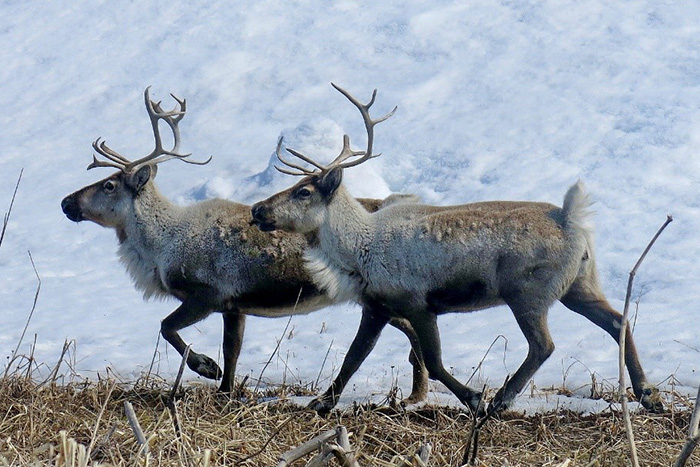
Females reindeer. Photograph by Vitali Ushakov
The body length of adult animals is 1,5-2,2 m, the weight is 100-220 kg. Newborn calves weigh 5-6 kg.
The area of reindeer includes arctic and taiga zones of Eurasia and North America. The southern boundary of habitation passes approximately at 58-59° northern latitude.
Reindeer - the only members of the family, in which both males and females have horns. Horns of males begin to grow in April, and in late August and early September they shed the skin. After the rut in November – December males shed their horns. Females shed the horns after calving in May-June.
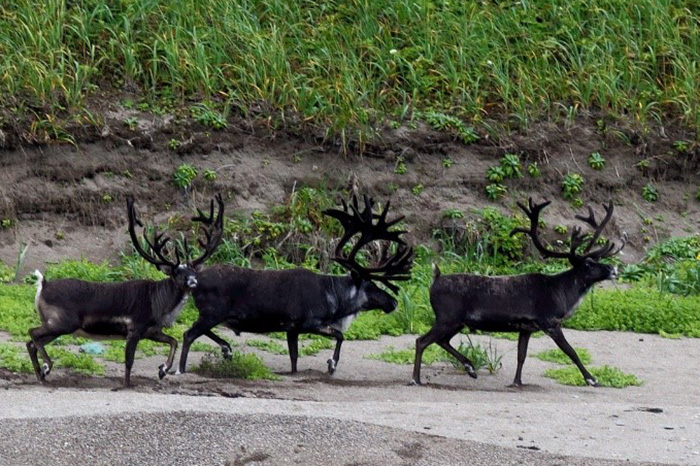
In August the horns of males stop growing. Photograph by Eugene Mamaev
The ration includes a variety of grass, leaves and shoots of shrubs and dwarf birch, in winter – lichens. The lack of minerals and protein is compensated by mouse-like rodents, bird eggs and chicks. For the same reason, they gnaw horns and bones, eat marine emissions. The reindeer has a well-developed sense of smell: it can smell the reindeer moss under the snow at a depth of 1 m. At a depth of snow more than that deer leave these places as they are not able to graze there. They spend up to 66% of time during a day on feeding. In summer for normal feeding one deer takes an average of 3,2 ha, and in winter– 12-18 ha. During a day the deer can eat up to 22 kg of feed.
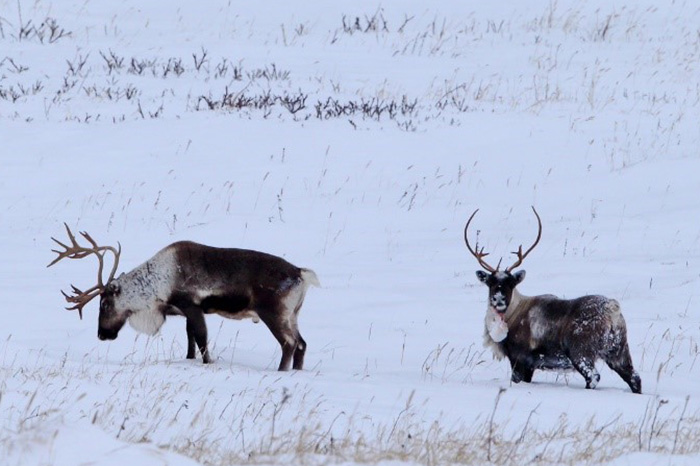
On Bering Island due to lack of large quantities of lichen reindeer feed on a variety of plant food throughout the year. Photograph by Eugene Mamaev
Seasonal migrations, which at times have a length of several hundred kilometers, are typical of reindeer. In mountainous habitats reindeer spend summer in the mountains and in winter move to the plains or woodland.
The rut of the reindeer takes place in September-November. The duration of pregnancy is 192-246 days. Calving happens in May-June. As a rule, one cub is born. Already in a week calves run well and can swim. Lactation continues until fall or even winter. Sexual maturity occurs by the second year of life. Males begin to breed at 3 years when they are mature physically enough. Life expectancy is up to 25 years.
The reindeer has its peculiarity – almost complete absence of sweat glands that is why when running it has to put the tongue out for thermoregulation.
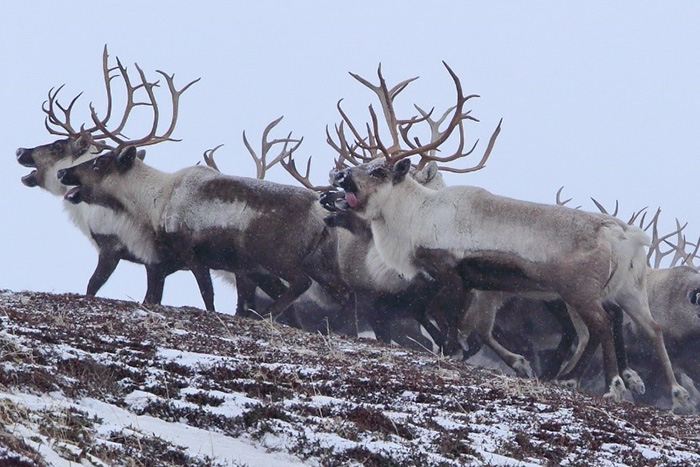
Because of the absence of sweat glands reindeer have to put the tongue out for thermoregulation while running. Photograph by Eugene Mamaev
The domesticated reindeer was acclimated on Bering Island.
For the first time on Bering Island 15 reindeer (4 males and 11 females) were brought from Kamchatka and released July 15, 1882 on the initiative of Dybowski B. According to specific information deer were caught on the west coast of Kamchatka (rural settlement Khairyuzovo). All deer from this release disappeared by 1917. For the second time deer (15 females and 2 males) were brought from Karaginsky Island in 1927. Last time deer were brought again from Karaginsky Island in 1984 (16 females and 16 males).
Seasonal migrations are typical of reindeer on Bering Island, due to the limited area of the island migrations are not as extended as on the mainland area. Nevertheless, there can be seen a clear tendency to change habitats by seasons.
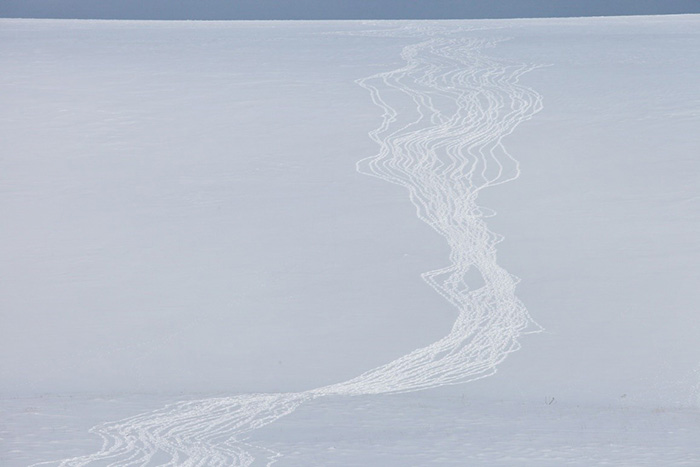
Footprints in the snow belonging to the reindeer herd. Photograph by Eugene Mamaev
In summer the main part of Bering reindeer population is concentrated in the mountainous southern part of the island. During summer reindeer groups are small. In August and early September deer begin to gather in larger groups, but stay still in the southern half of the island.
With the onset of winter the majority of the herd goes to the flat northern part. Here can concentrate up to 70% of the whole population. In March, when the depth of snow cover comes to its maximum and conditions for foraging in the mountainous part of the island are extremely difficult, in the plains in the north of the island herds of reindeer are formed with more than 300 individuals.
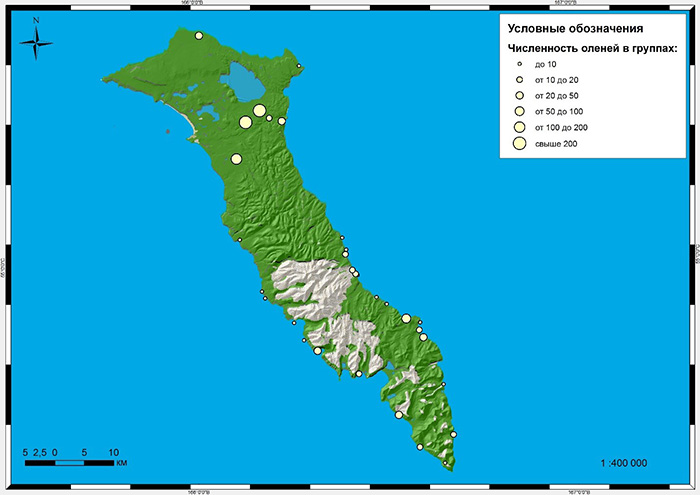
The spaсial distribution of reindeer on Bering Island in early spring
Some deer stay in the mountainous part of the island throughout the winter. For example, small groups of reindeer (5-30 animals) during winter can be seen on the high steep slopes above the western sea coast in the south of the island. The heights of the cliffs here are up to 100 meters or more. Snow drifts form deep snow which makes reindeer stay on the patch of ground with sparse vegetation. Because of such extreme conditions part of reindeer dies, falling down from the cliffs or through negligence, or due to avalanches which are pretty common in this part of the island. Sometimes the whole group dies.
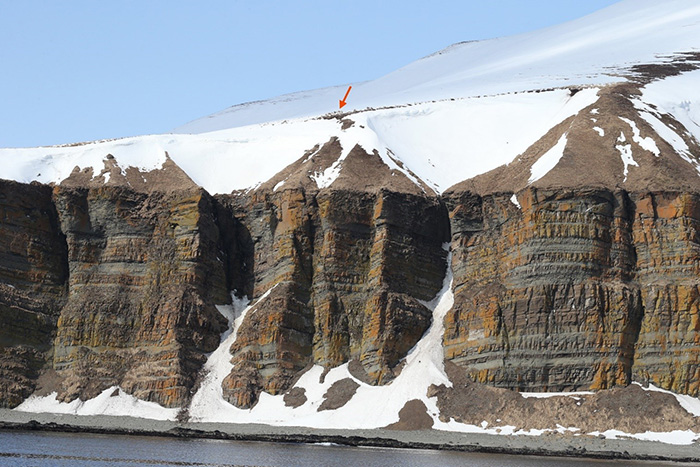
Habitat of reindeer in the southern mountainous part of the island. The pointer shows a group of reindeer. Photograph by Eugene Mamaev
In summer food of reindeer on Bering Island is rather varied, due to the rapid growth of vegetation. In winter crowberry is the major part of their ration.
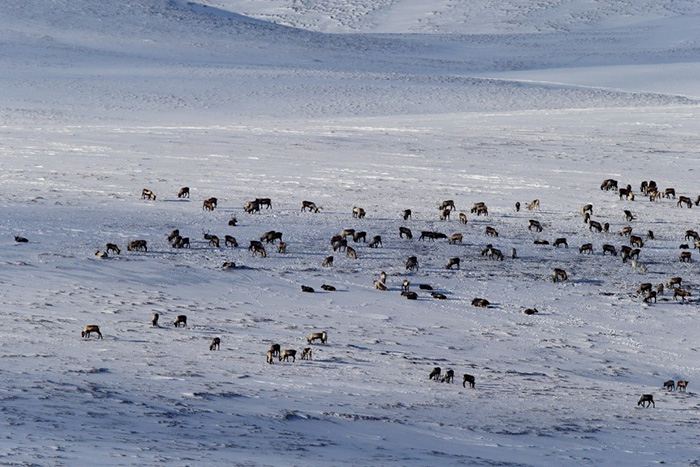
In winter in the northern part of Bering Island deer form large herds, sometimes consisting of hundreds of individuals. Here they can get their main winter food, bushes of crowberry, in abundance. Photograph by Eugene Mamaev
The reindeer on Bering Island is a non-indigenous species. The ecosystem of the island has evolved in the absence of this phytophagous species that is why it is very unstable to its negative impact. So it is not a coincidence that researchers in the late 80s of the last century pointed out the serious negative consequences of increasing the number of deer on Bering Island. They considered 400 individuals the optimal number of species on the island. For this reason, lichen tundra on Bering Island was «knocked out» by deer already in the 30s of the last century. The destructive activity of deer on the island also leads to landslides. Deer because of their biological characteristics destroy nests of ground-nesting birds. Taking into account that now the area where the reindeer lives is the territory of the reserve, the role of this species is highly ambiguous.
The current number of reindeer on Bering Island according to recent data (in spring) is up to 1,5 ths individuals.









